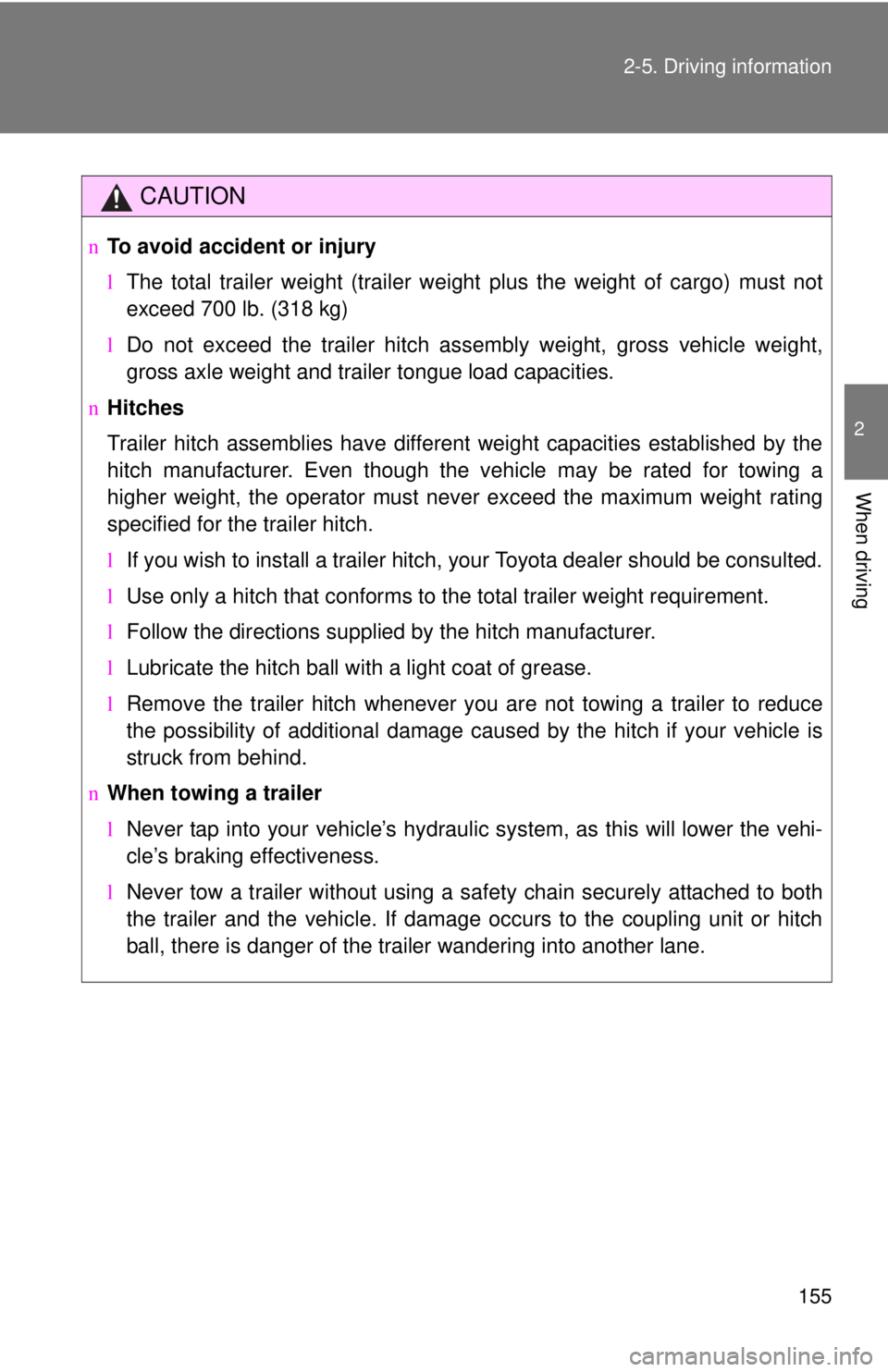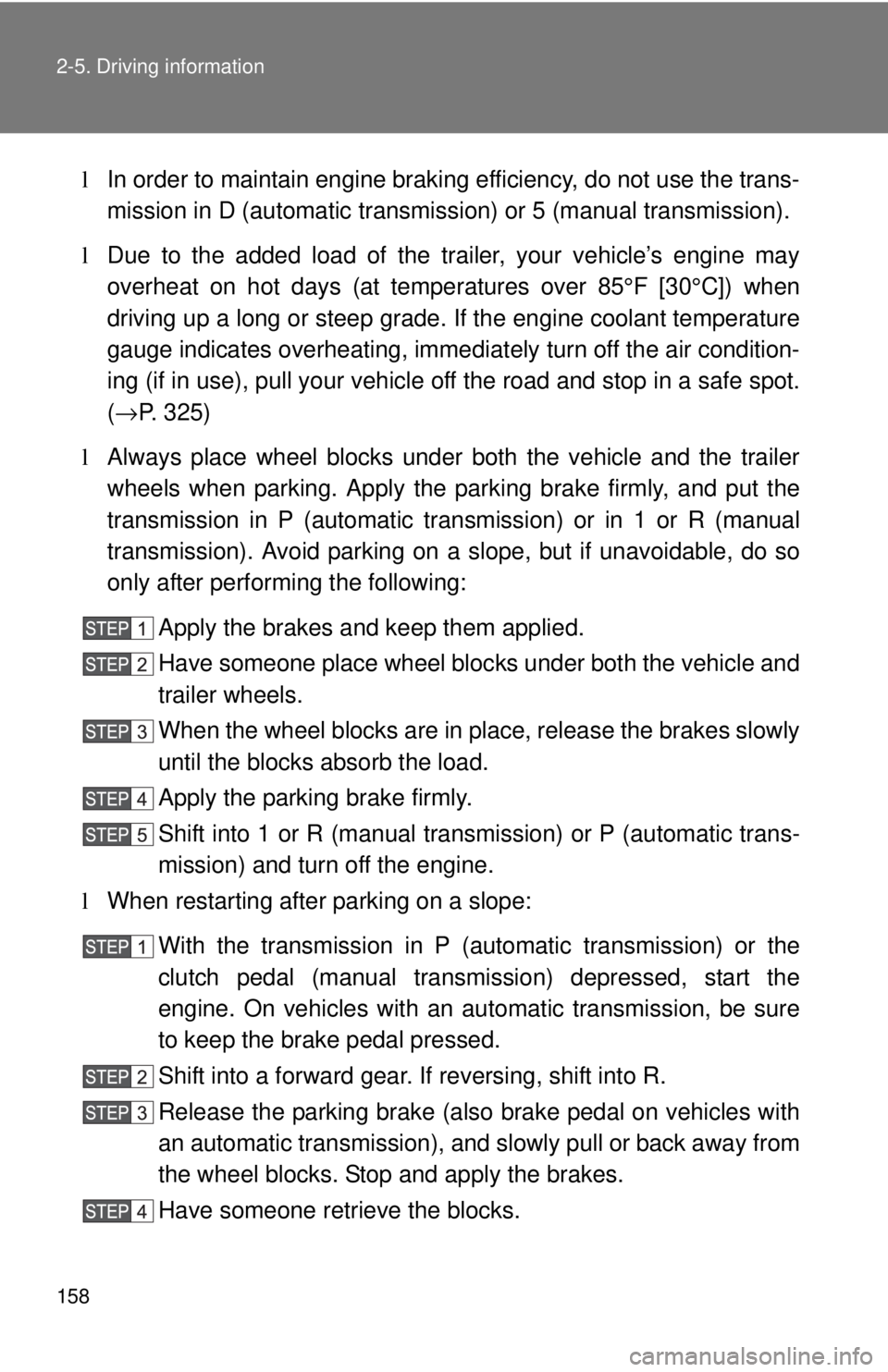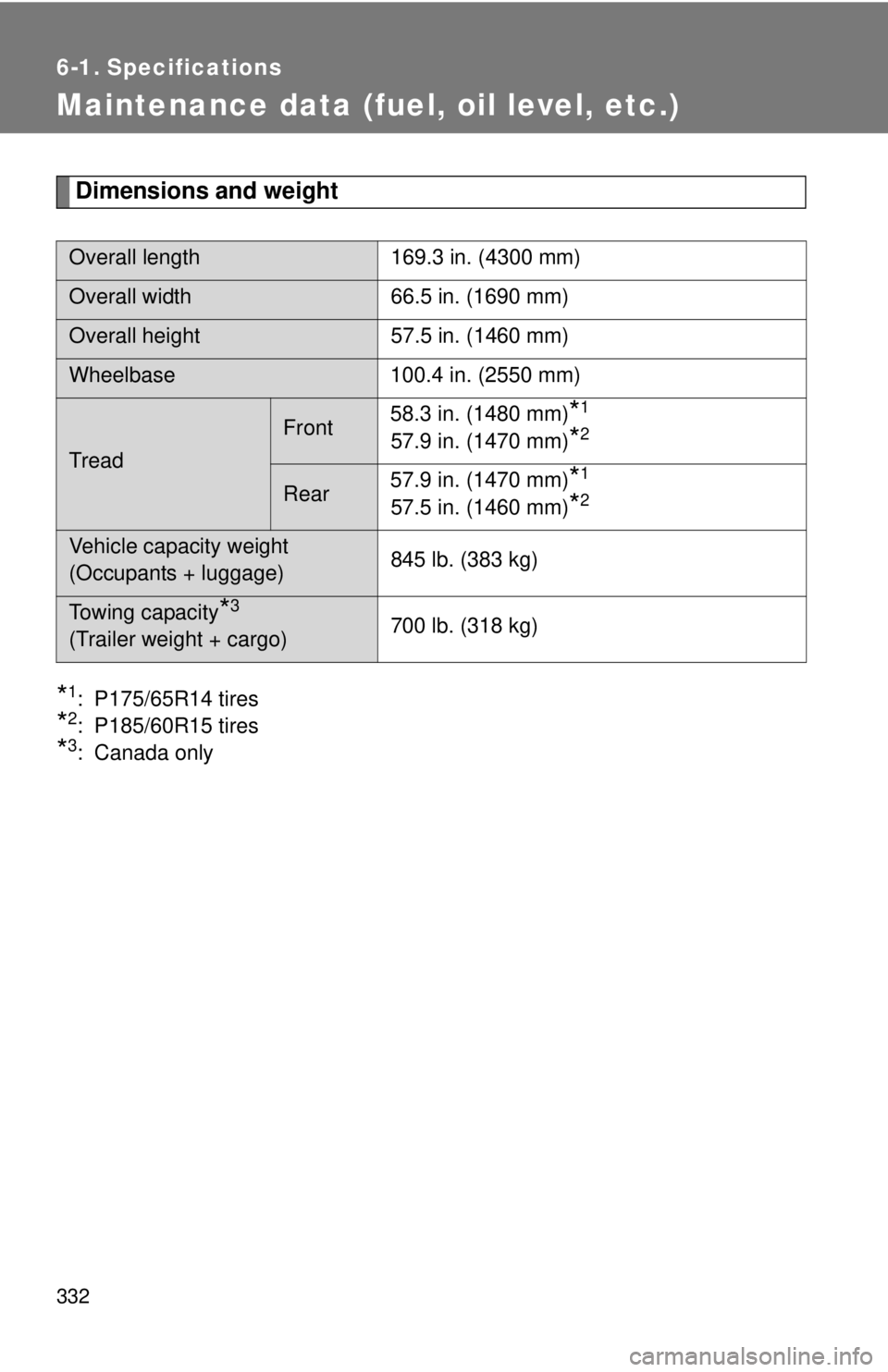2010 TOYOTA YARIS SEDAN trailer
[x] Cancel search: trailerPage 168 of 386

155
2-5. Driving information
2
When driving
CAUTION
n
To avoid accident or injury
lThe total trailer weight (trailer weight plus the weight of cargo) must not
exceed 700 lb. (318 kg)
l Do not exceed the trailer hitch assembly weight, gross vehicle weight,
gross axle weight and trailer tongue load capacities.
n Hitches
Trailer hitch assemblies have different weight capacities established by the
hitch manufacturer. Even though the vehicle may be rated for towing a
higher weight, the operator must never exceed the maximum weight rating
specified for the trailer hitch.
lIf you wish to install a trailer hitch, your Toyota dealer should be consulted.
l Use only a hitch that conforms to the total trailer weight requirement.
l Follow the directions supplied by the hitch manufacturer.
l Lubricate the hitch ball with a light coat of grease.
l Remove the trailer hitch whenever you are not towing a trailer to reduce
the possibility of additional damage caused by the hitch if your vehicle is
struck from behind.
n When towing a trailer
lNever tap into your vehicle’s hydraulic system, as this will lower the vehi-
cle’s braking effectiveness.
l Never tow a trailer without using a safety chain securely attached to both
the trailer and the vehicle. If damage occurs to the coupling unit or hitch
ball, there is danger of the trailer wandering into another lane.
Page 169 of 386

156 2-5. Driving information
Trailer towing tipsYour vehicle will handle differently w hen towing a trailer. In order to
avoid accident, death or serious in jury, keep the following in mind
when towing:
l Before starting out, check the trailer’s light and the vehicle-trailer
connections. Recheck after driving a short distance.
l Practice turning, stopping and reve rsing with the trailer attached in
an area away from traffic until you become accustomed to the feel
of the vehicle.
NOTICE
n When installing a trailer hitch
Use only the position recommended by your Toyota dealer. Do not install the
trailer hitch on the bumper; this may cause body damage.
n Brakes
Toyota recommends trailers with brakes that conform to any applicable fed-
eral and state/provincial regulations.
n Safety chain
A safety chain must always be used between the towing vehicle and the
trailer. Leave sufficient slack in the chain for turns. The chain should cross
under the trailer tongue to prevent the tongue from dropping to the ground in
the case that it becomes damaged or separated. For the correct safety chain
installation procedure, ask your Toyota dealer.
n Do not directly splice trailer lights
Directly splicing may damage your vehicle’s electrical system and cause a
malfunction.
Page 170 of 386

157
2-5. Driving information
2
When driving
l
Reversing with a trailer attached is difficult and requires practice.
Grip the bottom of the steering wheel and move your hand to the
left to move the trailer to the left. Move your hand to the right to
move the trailer to the right. (Thi s is generally opposite to reversing
without a trailer attached.) Avoid sharp or prolonged turning. Have
someone guide you when reversing to reduce the risk of an acci-
dent.
l As stopping distance is increased when towing a trailer, vehicle-to-
vehicle distance should be increased. For each 10 mph (16 km/h)
of speed, allow at least o ne vehicle and trailer length.
l Avoid sudden braking as you may skid, resulting in jackknifing and
loss of control. This is especiall y true on wet or slippery surfaces.
l Avoid jerky starts or sudden acceleration. Vehicles with a manual
transmission, prevent excessive cl utch slippage by keeping engine
rpm low and not racing the engine. Always start out in first gear.
l Avoid jerky steering and sharp turns, and slow down before mak-
ing a turn.
l Note that when making a turn, th e trailer wheels will be closer than
the vehicle wheels to the inside of the turn. Compensate by making
a larger than normal turning radius.
l Crosswinds and rough roads will adversely affect handling of your
vehicle and trailer, causing sway . Periodically check the rear to
prepare for being passed by large trucks or buses, which may
cause your vehicle and trailer to sway. If swaying occurs, firmly grip
the steering wheel, reduce speed immediately but gradually, and
steer straight ahead. Never increase speed. If you make no
extreme correction with the stee ring or brakes, your vehicle and
trailer will stabilize.
l Take care when passing other vehicles. Passing requires consider-
able distance. After passing a vehicle, do not forget the length of
your trailer, and be sure you hav e plenty of room before changing
lanes.
Page 171 of 386

158 2-5. Driving information
lIn order to maintain engine braking efficiency, do not use the trans-
mission in D (automatic transmission) or 5 (manual transmission).
l Due to the added load of the trailer, your vehicle’s engine may
overheat on hot days (at temper atures over 85°F [30°C]) when
driving up a long or steep grade. If the engine coolant temperature
gauge indicates overheating, immediately turn off the air condition-
ing (if in use), pull your vehicle off the road and stop in a safe spot.
( → P. 325)
l Always place wheel blocks under both the vehicle and the trailer
wheels when parking. Apply the parking brake firmly, and put the
transmission in P (automatic transmission) or in 1 or R (manual
transmission). Avoid parking on a slope, but if unavoidable, do so
only after performing the following:
Apply the brakes and keep them applied.
Have someone place wheel bloc ks under both the vehicle and
trailer wheels.
When the wheel blocks are in place, release the brakes slowly
until the blocks absorb the load.
Apply the parking brake firmly.
Shift into 1 or R (manual transmission) or P (automatic trans-
mission) and turn off the engine.
l When restarting after parking on a slope:
With the transmission in P (automatic transmission) or the
clutch pedal (manual transmission) depressed, start the
engine. On vehicles with an au tomatic transmission, be sure
to keep the brake pedal pressed.
Shift into a forward gear. If reversing, shift into R.
Release the parking brake (also brake pedal on vehicles with
an automatic transmission), and slowly pull or back away from
the wheel blocks. Stop and apply the brakes.
Have someone retrieve the blocks.
Page 172 of 386

159
2-5. Driving information
2
When driving
CAUTION
n
To avoid an accident
lDo not exceed 45 mph (72 km/h) or posted towing speed limit, whichever
is lower. As instability (swaying) of the towing vehicle-trailer combination
increases as speed increases, exceeding 45 mph (72 km/h) may cause
loss of control.
l Slow down and downshift before descending steep or long downhill
grades. Do not make sudden downshifts.
l Avoid holding the brake pedal down too long or too frequently. This could
cause the brakes to overheat and result in reduced braking efficiency.
Page 341 of 386

332
6-1. Specifications
Maintenance data (fuel, oil level, etc.)
Dimensions and weight
*1: P175/65R14 tires
*2: P185/60R15 tires
*3: Canada only
Overall length169.3 in. (4300 mm)
Overall width66.5 in. (1690 mm)
Overall height 57.5 in. (1460 mm)
Wheelbase100.4 in. (2550 mm)
Tread
Front58.3 in. (1480 mm)*1
57.9 in. (1470 mm)*2
Rear57.9 in. (1470 mm)*1
57.5 in. (1460 mm)*2
Vehicle capacity weight
(Occupants + luggage) 845 lb. (383 kg)
Towing capacity*3
(Trailer weight + cargo)700 lb. (318 kg)
Page 381 of 386

375
Alphabetical index
Ignition switch ....................... 110
Hazard lights switch ............. 286
Headlights switch ................. 130
Light switch........................... 130
Power door lock switch........... 28
Power window switch ............. 56
Turn signal lights .................. 117
VSC OFF switch ................... 140
Window lock switch ................ 57
Wiper and washer ................ 133
Tachometer .............................. 121
Tail lights Indicator................................ 130
Replacing light bulbs ............ 274
Switch ................................... 130
Wattage ................................ 342
Theft deterrent system Alarm ...................................... 64
Engine immobilizer system..... 62
Theft prevention labels ........... 66
Theft prevention labels ............. 66
Tire inflation pressure ............ 252
Tire information Glossary ............................... 353
Size ...................................... 350
Tire identification number ..... 349
Uniform tire quality
grading ............................... 351
Tires Chains .................................. 148
Checking .............................. 246
If you have a flat tire ............. 307
Identification number ............ 346
Inflation pressure .......... 252, 341
Inflation pressure sensor ...... 247
Information ........................... 346
Replacing ..................... 246, 307
Rotating tires ........................ 246
Size ...................................... 341
Snow tires............................. 148
Spare tire .............................. 307 Tire pressure warning
system ........................246, 300
Warning light .........................300
Tools .........................................307
Total load capacity...................147
Towing Dinghy towing................160, 161
Emergency towing.................287
Trailer towing.................151, 152
Trip meter .................................124
Trunk ...........................................33
Trunk light Wattage .................................342
Turn signal lights
Indicator ................................117
Lever .....................................117
Replacing light bulbs .............274
Switch....................................117
Wattage .................................342
Vanity mirrors...........................207
Vehicle identification number ...................................333
Vehicle stability control...........139
VSC............................................139
Warning buzzers Brake system ........................297
Seat belt reminder .................300
Warning lights
ABS .......................................298
Airbag system .......................298
Anti-lock brake system ..........298
Brake system ........................297
Charging system .... ...............298
Driver’s seat belt ...................300
Electric power steering
system ................................298
Electronic engine control
system ................................298
Engine oil replacement..........300
EPS system...........................298
T
V
W